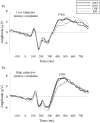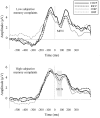Event-Related Potentials Reveal Altered Executive Control Activity in Healthy Elderly With Subjective Memory Complaints
- PMID: 30487741
- PMCID: PMC6246637
- DOI: 10.3389/fnhum.2018.00445
Event-Related Potentials Reveal Altered Executive Control Activity in Healthy Elderly With Subjective Memory Complaints
Abstract
Several studies reported that healthy elderly with subjective memory complaints (SMC) evolve to Alzheimer's disease (AD) more frequently than elderly without subjective memory decline. In the present study, we investigated event-related potentials (ERPs) associated to executive control processes taking place during the performance of a Simon task with two irrelevant dimensions (stimulus position and direction pointed by an arrow) in healthy elderly divided in low and high SMC (LSMC, HSMC) groups. P300 was studied as a correlate of working memory. Medial frontal negativity (MFN) was studied as a correlate of conflict monitoring. Whereas the LSMC group showed interference from the stimulus position, participants with HSMC showed interference from both irrelevant dimensions. P300 latency was longer and P300 amplitude was lower when the stimulus position was incompatible with the required response but differences between both groups were not observed. MFN was not modulated in the LSMC group; however, the HSMC group showed larger MFN when the stimulus position and/or the direction pointed by the arrow were incompatible with the required response. These results suggest that participants with HSMC deployed greater conflict monitoring activity to maintain the performance when the target stimulus contained conflictive spatial information.
Keywords: aging; event-related potentials; executive functions; simon task; subjective memory complaints.
Figures




Similar articles
-
Event-related brain potential indexes provide evidence for some decline in healthy people with subjective memory complaints during target evaluation and response inhibition processing.Neurobiol Learn Mem. 2021 Jul;182:107450. doi: 10.1016/j.nlm.2021.107450. Epub 2021 Apr 30. Neurobiol Learn Mem. 2021. PMID: 33933631
-
Similarities and differences between interference from stimulus position and from direction of an arrow: behavioral and event-related potential measures.Int J Psychophysiol. 2013 Nov;90(2):180-9. doi: 10.1016/j.ijpsycho.2013.07.002. Epub 2013 Jul 13. Int J Psychophysiol. 2013. PMID: 23856354
-
N2pc is modulated by stimulus-stimulus, but not by stimulus-response incompatibilities.Biol Psychol. 2013 Apr;93(1):75-80. doi: 10.1016/j.biopsycho.2013.01.010. Epub 2013 Feb 1. Biol Psychol. 2013. PMID: 23380335
-
Inhibition deficit in the spatial tendency of the response in multiple-domain amnestic mild cognitive impairment. An event-related potential study.Front Aging Neurosci. 2015 May 6;7:68. doi: 10.3389/fnagi.2015.00068. eCollection 2015. Front Aging Neurosci. 2015. PMID: 25999853 Free PMC article.
-
[Memory traces in EEG].Z Exp Psychol. 1997;44(1):4-37. Z Exp Psychol. 1997. PMID: 9498923 Review. German.
Cited by
-
The Importance of Subjective Cognitive Decline Recognition and the Potential of Molecular and Neurophysiological Biomarkers-A Systematic Review.Int J Mol Sci. 2023 Jun 15;24(12):10158. doi: 10.3390/ijms241210158. Int J Mol Sci. 2023. PMID: 37373304 Free PMC article.
-
Subjective cognitive decline in healthy older adults is associated with altered processing of negative versus positive feedback in a probabilistic learning task.Front Psychol. 2024 Jul 10;15:1404345. doi: 10.3389/fpsyg.2024.1404345. eCollection 2024. Front Psychol. 2024. PMID: 39049950 Free PMC article.
-
Neurophysiological markers of early cognitive decline in older adults: a mini-review of electroencephalography studies for precursors of dementia.Front Aging Neurosci. 2024 Oct 18;16:1486481. doi: 10.3389/fnagi.2024.1486481. eCollection 2024. Front Aging Neurosci. 2024. PMID: 39493278 Free PMC article. Review.
-
Neurophysiological markers in community-dwelling older adults with mild cognitive impairment: an EEG study.Alzheimers Res Ther. 2023 Dec 15;15(1):217. doi: 10.1186/s13195-023-01368-6. Alzheimers Res Ther. 2023. PMID: 38102703 Free PMC article.
-
Subjective Memory Complaints and Decision Making in Young and Older Adults: An Event-Related Potential Study.Front Aging Neurosci. 2021 Nov 3;13:695275. doi: 10.3389/fnagi.2021.695275. eCollection 2021. Front Aging Neurosci. 2021. PMID: 34803649 Free PMC article.
References
-
- Bargh J. A., Chartrand T. L. (2000). “The mind in the middle: a practical guide to priming and automaticity research,” in Handbook of Research Methods in Social Psychology, eds Reis H. T., Hudd C. M. (Cambridge: Cambridge University Press; ), 253–285.
-
- Benedet M. J., Seisdedos N. (1996). Evaluación Clínica de las Quejas de Memoria en la Vida Cotidiana. Buenos Aires: Médica Panamericana.
LinkOut - more resources
Full Text Sources
Miscellaneous

